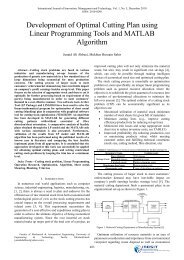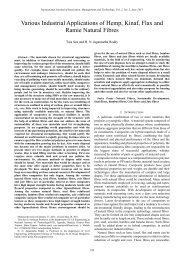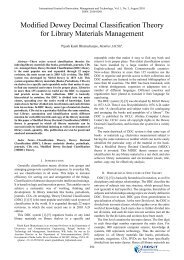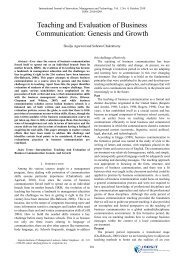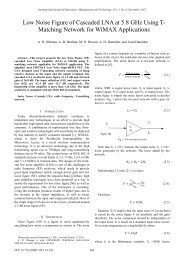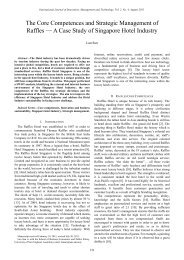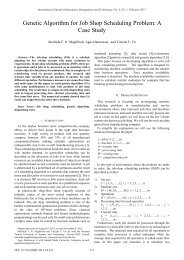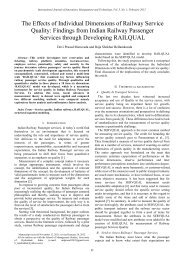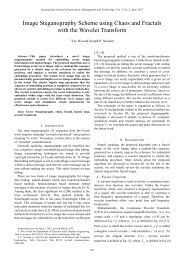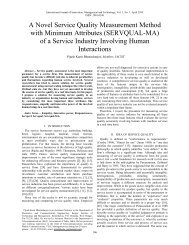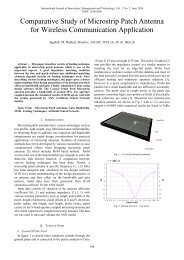The Barriers to SMEs' Implementation of Lean Production and ... - ijimt
The Barriers to SMEs' Implementation of Lean Production and ... - ijimt
The Barriers to SMEs' Implementation of Lean Production and ... - ijimt
You also want an ePaper? Increase the reach of your titles
YUMPU automatically turns print PDFs into web optimized ePapers that Google loves.
International Journal <strong>of</strong> Innovation, Management <strong>and</strong> Technology, Vol. 1, No. 2, June 2010ISSN: 2010-0248C. <strong>The</strong> successful experience <strong>of</strong> the implementation <strong>of</strong>lean production in CHINT1) Promoting reform through “Phoenix Project”Through cooperating with GE, Mr. Nan realized thatthere were only 5% similarities between CHINT <strong>and</strong> GE. Asa result, shortly after the cooperation with GE, Mr. Nan putforward the ‘Phoenix Project’, that is, through theimplementation <strong>of</strong> lean production, making a series <strong>of</strong>reforms in the company. Mr. Nan also actively involvedpersonally in the creation <strong>of</strong> the learning organization.Mr. Nan said that he must let everyone in CHINTexperience such a management revolution. Although theywill suffer the pain, but have not experienced ‘death’, theywould have experienced “rebirth” hope.2) <strong>The</strong> exchange <strong>of</strong> management experience, <strong>to</strong> create anatmosphere <strong>of</strong> reform<strong>The</strong> implementation <strong>of</strong> lean production ranges fromdrawing up strategies <strong>to</strong> the specific job responsibilities in allaspects <strong>of</strong> business operation. <strong>The</strong> people in CHINT believethat they must do a good job in every aspect <strong>of</strong> business <strong>to</strong>finish the management revolution.In order <strong>to</strong> implement lean production successfully, theylaunched a ‘CHINT Forum’ for the exchange <strong>of</strong> managementexperience from time <strong>to</strong> time <strong>and</strong> <strong>to</strong> create an atmosphere <strong>of</strong>reform.3) <strong>The</strong> establishment <strong>of</strong> an effective evaluation system <strong>to</strong>measure the effectiveness <strong>of</strong> lean productionFor the implementation <strong>of</strong> lean manufacturing enterprise,it must be concerned whether or not the staff's ability isimproved, their processes <strong>and</strong> operations are becomingincreasingly sophisticated, <strong>and</strong> all the members concernsabout reducing waste. <strong>The</strong>refore CHINT developed detailedtechnical st<strong>and</strong>ards for various positions.In addition, CHINT also encourage staff <strong>to</strong> take theinitiative <strong>to</strong> explore the problems <strong>of</strong> production process,management structure, <strong>and</strong> staff capacity; advocate staff <strong>to</strong>make reasonable proposals.With performance st<strong>and</strong>ards, CHINT also put forwardthe slogan <strong>of</strong> ‘allowing more employees <strong>to</strong> becomemillionaires <strong>and</strong> even multi-millionaire’.Each year they produce 10% <strong>of</strong> excess reward <strong>and</strong> 5% ~10% <strong>of</strong> new products reward <strong>to</strong> reward stuff.V. CONCLUSIONSThrough questionnaires <strong>and</strong> a case study, this researchsuggests two major findings.Firstly, that few SMEs implement lean production isbecause that many companies having not heard <strong>of</strong> leanproduction; misunderst<strong>and</strong>ing <strong>of</strong> lean production; the staffs’resistance <strong>to</strong> lean production; implementing lean productionmechanically without revision according <strong>to</strong> the environmen<strong>to</strong>f enterprise.Secondly, the implementation <strong>of</strong> lean production is arevolutionary reform <strong>of</strong> all the processes <strong>and</strong> work habits inenterprise. In order <strong>to</strong> enable reform <strong>of</strong> the implementation <strong>of</strong>lean production successfully, SMEs should take actions <strong>of</strong>the attention <strong>and</strong> involvement <strong>of</strong> senior manager, theestablishment <strong>of</strong> effective communication <strong>and</strong> learningplatform, <strong>and</strong> establishment <strong>of</strong> the performance appraisalsystem.This study has one limitation, which in turn form areas forfuture research. This study does not analyze the fac<strong>to</strong>rs <strong>of</strong>government <strong>and</strong> supply chain member <strong>to</strong> SMEs. Futureresearch should examine this two fac<strong>to</strong>rs effect <strong>and</strong> takemeasures according them.ACKNOWLEDGMENTWe would especially like <strong>to</strong> thank the Edi<strong>to</strong>r for severalcomments <strong>and</strong> suggestions that have vastly improved thepaper, allowing us <strong>to</strong> learn more about the academic research.REFERENCES[1] Womack, J. p., Jones D. t <strong>and</strong> Roos, D. <strong>The</strong> machine that changed theworld: the triumph <strong>of</strong> lean production. New York: Rawson Macmillan,1990[2] Harvard Business Review on managing the Value Chain. HarvardBusiness School Press,2000,222-230[3] Jens von Axelson. Developing <strong>Lean</strong> <strong>Production</strong> implementationmethodology for SME learning networks.16th International AnnualEurOMA Conference,2009[4] Price J., “<strong>Lean</strong> production at Suzuki <strong>and</strong> Toyota: a his<strong>to</strong>ricalperspective”, Studies in Political Economy, 1994,Vol. 45:66-99[5] Kenney M. <strong>and</strong> Florida, R., “<strong>The</strong> transfer <strong>of</strong> Japanese managementstyles in two US transplant industries: au<strong>to</strong>s <strong>and</strong> electronics”, Journal<strong>of</strong> Management Studies, 1995,Vol.32:789-801[6] James-Moore, S. <strong>and</strong> Gibbons, A., “Is lean manufacture universallyrelevant?”, International Journal <strong>of</strong> Operations & <strong>Production</strong>Management, 1997, Vol. 17 No. 9: 899-911[7] Richard Cooney, “Is ‘lean’ a universal production system?”,International Journal <strong>of</strong> Operations & <strong>Production</strong> Management,2002,Vol.22: 1130-1147[8] Bartezzaghi, E., “<strong>The</strong> evolution <strong>of</strong> production models: is a newparadigm emerging?”, International Journal <strong>of</strong> Operations &<strong>Production</strong> Management, 1999,Vol.19 No. 2:1130-1147[9] James P. Womack <strong>and</strong> Daniel T. Jones, <strong>Lean</strong> thinking, CommercialPress, 2005:3-6[10] Zhang jun-guo <strong>and</strong> Yang wei-xia, <strong>The</strong> Obstacles in CorporateOrganizational Reform, Business Studies, 2006, (9): 78-81[11] von Axelson J., On the development <strong>of</strong> production methods for transfer<strong>to</strong> small <strong>to</strong> medium-sized enterprises, doc<strong>to</strong>ral thesis, Department <strong>of</strong><strong>Production</strong> Engineering, <strong>The</strong> Royal Institute <strong>of</strong> Technology, 2007[12] Bititchi U., Martinez V., Albores P. <strong>and</strong> Parung J., “Creating <strong>and</strong>managing value in collaborative networks”, International Journal <strong>of</strong>Physical Distribution & Logistics Management, 2004,Vol. 34 No.3/4:pp.251-268[13] Zhao qiong-shan, How <strong>to</strong> achieve the type <strong>of</strong> mutation in PhoenixNirvana, China Quality, 2007, (6) : 88-89[14] Kuang xiao-lin, Making the ‘one-flow’ more lively, CHINT Journal,2008,5: 28First A. Yang pingyu was born on January 15, 1977 in Fujian provinceChina. He studies on management science for PhD at Shanghai University,<strong>and</strong> majors in production <strong>and</strong> operation management.He works in the City College <strong>of</strong> Wenzhou University, Wenzhou, China.He had worked in a company as production manager. previous publicationsHis previous publications is followed:[1] An Analysis <strong>of</strong> the Fac<strong>to</strong>r Affecting the Effective <strong>Implementation</strong> <strong>of</strong><strong>Lean</strong> production—a case study. 2009 West lake international conference onSMB, 2009.10[2]A game <strong>of</strong> pr<strong>of</strong>it division by slotting fees in supply chain. 2010 IEEEInternational Conference on Advanced Management Science.2010.4224



